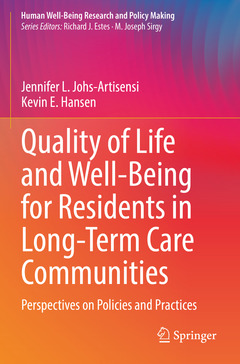Table of Contents
1 Quality of Life in Long-Term Care
1.1 Aging Demographics Across the Globe
1.2 Defining “Good” Quality of Life
1.3 Long-Term Care Communities
1.4 The Decision to Move into a Long-Term Care Community
1.5 Influence of Quality of Life on Other Metrics
1.6 Enhancing Resident Quality of Life
1.7 Quality of Care vs. Quality of Life
1.8 Balance Between Safety and Autonomy
1.9 Resident-Defined Quality of Life
1.10 Quality of Life Domains
2 Resident Autonomy, Dignity, and Respect
2.1 Respect
2.2 Autonomy
2.3 Dignity
2.4 Sense of Purpose
2.5 Respect, Autonomy, Purpose, and Dignity in Residential Care Communities
2.5.1 The Golden Rule
2.5.2 Autonomy, Choice, and Control
2.6 Essential Influencers
2.6.1 Nurses and Nurse Aides
2.6.2 Social Workers and Admissions Directors
2.6.3 Activities Directors and Aides
2.6.4 Dietary Directors and Aides
3 Relationships with Other Residents, Staff, and Family Members
3.1 Peer Relationships
3.1.1 Care Recipients are Unique
3.1.2 How Residents Develop Peer Relationships
3.1.3 Potential Barriers to Peer Relationships
3.1.4 Facilitating Positive Peer Relationships
3.2 Resident – Staff Relationships
3.2.1 How Resident – Staff Relationships Develop
3.2.2 Optimizing Resident – Staff Relationships
3.3 Resident – Family Relationships
3.3.1 Family Member Roles
3.3.2 Facilitating Resident-Family Relationships
3.4 Romantic Resident Relationships
3.4.1 Supporting Romantic Resident Relationships
3.5 Essential Influencers
3.5.1 Nursing and Direct Care Staff
3.5.2 Social Workers
3.5.3 Activities Director and Aides
3.5.4 Dining Staff
3.5.5 Volunteers
4 Activities and Religious Practices
4.1 Psychosocial Benefits of Activities
4.2 Frequency and Variety of Activities
4.3 Adapting Activities for Residents with Impairments
4.4 Religious and Spiritual Activities
4.5 Essential Influencers
4.5.1 Activities Director
4.5.2 Activity Aides and Volunteers
4.5.3 Social Workers
4.5.4 Therapists
4.5.5 Clergy
5 Environment and Surroundings
5.1 Use of Homelike Design Principles
5.1.1 Homelike and Hospitable Care
5.1.2 Resident Bedrooms
5.1.2.1 Privacy
5.1.2.2 Personal Belongings
5.1.2.3 Autonomy Over Personal Environment
5.1.2.4 Bathrooms
5.1.3 Design of Communal Spaces
5.1.3.1 Caregiver Workspace
5.1.3.2 Living, Lounging, and Activity Spaces
5.1.3.3 Kitchen and Dining
5.1.3.4 Shower and Tub Rooms or “Spas”
5.1.4 Environmental Comfortability
5.2 Creating Safe and Functional Access to the Outdoors
5.3 Environmental Considerations for Residents with Dementia
5.4 Essential Influencers
5.4.1 Social Workers
5.4.2 Maintenance Personnel
5.4.3 Nursing and Direct Care Staff
5.4.4 Activities Director
5.4.5 Dining Staff
6 Food and Dining
6.1 Aging Changes that Affect Food Consumption
6.2 Quality of Food and Menu Options
6.3 Modified Diets and Changes to Food Preparation for Resident Health Conditions
6.4 Improving the Dining Experience
6.5 The Dining Environment
6.6 Essential Influencers
6.6.1 Dieticians and Dietary Managers
6.6.2 Medical Director and Therapists
6.6.3 Dietary Aides
6.6.4 Nurse Aides
7 Quality of Care
7.1 Quality of Care
7.2 Intersection of Care and Quality of Life
7.3 Measuring and Assuring Quality
7.4 Providing Quality Resident Care and Therapy Services
7.5 Care Planning for Residents
7.6 Transfers Between Care Settings
7.7 Essential Influencers
7.7.1 Medical Director and Director of Nursing
7.7.2 Nursing Staff and Nurse Aides
7.7.3 Therapists and Service Staff
8 Summary, Policy Recommendations, and Conclusions
8.1 Care Recipients Should Direct Their Care
8.2 Administrators as Champions and Chief Influencers
8.3 Organizational and Leadership Support
8.4 Opportunities for Government Licensure and Regulatory Agencies
8.5 The Imperative and Charge to Improve Resident Quality of Life




